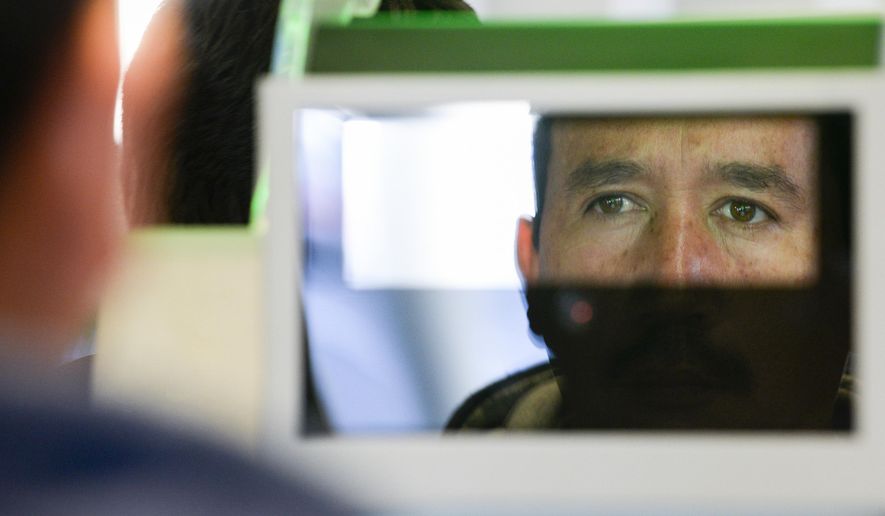The government flagged more than 1.6 million foreign visitors for overstaying their visas from 2013 to 2015, but deportation agents said they fell too low on President Obama’s list of priorities to bother targeting for removal, according to a watchdog report released Monday.
U.S. Immigration and Customs Enforcement, the deportation agency, concluded that it would cost too much to pursue the overstays, the Government Accountability Office said. ICE’s Enforcement and Removal Operations branch instead chose to focus on illegal immigrants who jumped the border and who amassed serious criminal records — the priorities Mr. Obama laid out.
Overstays pose an increasingly prominent problem in illegal immigration, with estimates saying that as the border has become more secure, migrants are attempting to enter by getting legal passes and refusing to leave when their time is up.
Some estimates say more than 40 percent of illegal immigrants each year arrived legally but overstayed.
While new border crossers were a priority for the Obama administration, overstays were not.
“ERO did not send any of the referrals to ICE field offices for enforcement action because the overstay lead referrals did not meet DHS’ enforcement priorities,” investigators said. “Specifically, ERO officials said that in most cases, overstay lead referrals do not have criminal convictions required to classify the referrals as DHS’ enforcement priority.”
The report said Homeland Security has made some strides in tracking visitors to see if they are leaving the country in time, including hosting several pilot programs to try to see what’s possible at airports and seaports.
But the department is still struggling to figure out how to expand those pilot programs to airports nationwide, and it lacks plans to cover the land ports of entry, where millions of visitors arrive by car or on foot each day.
A biometric entry-exit system has been required by law for years but has been difficult to build.
Homeland Security collects information on arrivals at airports when they go for passport and customs checks but says there aren’t the same kinds of facilities available to track departures. Land ports of entry are even tougher, with visitors arriving in cars and on foot, without any of the infrastructure that accompanies airports or seaports.
Homeland Security has tried a pilot program at Hartsfield-Jackson Atlanta International Airport using facial recognition software to try to track departures, and the agency said it’s reviewing those results to figure out how to expand to other airports.
President Trump last month issued an executive order demanding that the process be sped up. Mr. Trump demanded periodic reports on progress, including a first report in early May.
Current law also requires an annual report on overstays, but for years the department refused, saying its data weren’t good enough to have confidence in what it would report.
Last year, the administration released a partial report covering business and tourist visitors, calculating that about 1 percent of those who came to the U.S. overstayed. That worked out to more than 480,000 people in 2015 alone, the report said.
That figure didn’t include arrivals by land, nor did it include critical categories for overstays, such as student visas.
Homeland Security had promised a more complete report this year and told the GAO it would be released by the end of this month.
According to GAO data, Homeland Security flagged more than 2.7 million leads of potential visa overstays from 2013 to 2015. About 870,000 were quickly closed because officials determined that they eventually left or got some other legal status in the U.S.
Another 155,000 cases were still open, while 27,000 were sent to ICE’s special Homeland Security Investigations unit to be probed as public safety or national security threats.
More than 5,000 of those were put in deportation proceedings, while 369 were arrested on criminal charges, resulting in 300 convictions. All told, less than half a percent were subjected to punishments because of their overstay status.
The remaining 1.6 million that were flagged were sent to deportation officers at ERO, but none of them was ousted because of their overstay status.
Meanwhile, on the border, illegal immigration appeared to drop in January, compared with December, according to the latest numbers from U.S. Customs and Border Protection.
The numbers are still high compared with past years — indeed, it’s the worst January in records dating back to 2012.
But total apprehensions of migrants trying to sneak across the border fell on a month-to-month basis by 27 percent, to 31,575. The number of inadmissible migrants who showed up at the southwest’s ports of entry fell 28 percent, to 10,899.
Apprehensions are deemed an indicator of the overall flow: The more people caught, the more are believed to be getting through.
The flow always decreases in the deep months of the winter, before picking up again in the spring. Last year, Border Patrol apprehensions dropped 36 percent from December to January.
• Stephen Dinan can be reached at sdinan@washingtontimes.com.




Please read our comment policy before commenting.